Hockey drills for technique passing
- A player of Blue (1) passes the ball to e.g. player 2 of Orange. This team tries to score over the 23-metre line in a yellow goal.
- Blue interferes with the defending of the Orange and tries to capture the ball and score in the normal goal. When Blue is over the 23-metre line, the team-mate at the side-line is allowed to join the game.
- Blue substitutes with Orange after 2 goals from either team.
Tips Ball possession
- Pass with good speed and direction.
- Be available (outside of the field).
- Use the hard feint pass (flats and push).
Tips Not Ball possession
- Force the player in ball possession to the side.
- Provoke making mistakes.
- Perform a quick counter after conquering ball.
Tips Counter
- Force the player in ball possession to the side.
- Provoke making mistakes.
- Perform a quick counter after conquering ball
Make it easier
- Make the field deeper (towards the center line).
Make it more difficult
- 1 extra player per team.
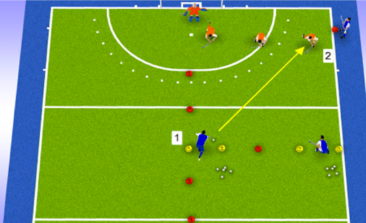
- The trainer (T) rolls the ball (1) to one of the four front players (for example A).
- Player A receiving the ball (2) plays a duel with player V1 opposite him.
- The goal is to score the ball at the opponent's goal.
- If V1 manages to intercept the ball, he plays it to V2.
- Now V2 may try to score with player B.
- After a goal, the form of play starts over again.
Making it easier
- Play a 1-1 duel on the two fields for a few minutes, after a goal, the substitute player comes into play.
Make it more difficult
- After the ball is taken by V1, V1 and V2 may try to score against player A (now it has become a 2-1 game).
- A has to defend.
- If A takes the ball, he plays it to player B.
- Player A and B play a 2-2 duel on players V1 and V2.
- Player 1 asks the ball in front of the pilons and receives the ball from player 3.
- At that moment player 2 grabs a ball and dribbles to the back line.
- Player 1 runs with his/her ball to the circle and finishes there.
- Then player 1 runs to the penaltyspot where he/she receives the ball from player 3.
- The ball is then finished on goal again.
- It works just like a normal game only now there's a square in the middle.
- If a shot or other foul is made, or if the ball has been out of bounds, the trainer throws/plays in a new ball from inside the square.
- The ball does not necessarily go to the same team or at the place where the foul was made.
- The size of the field depends on the number of players.
- Player 1 plays the ball to player 2 after which player 1 runs through
- Player 2 bounces the ball back to Player 1,
- Player 1 aligns the ball between the pilons (The player is not going to run into the "pilon box".)
Player 1 then finishes the ball at goal
You can speed up this exercise by placing the mirrored exercise on the other side, allowing you to play from 2 sides.
Aim:
To become physically as well as technically warm as preparation for the training.
Set up:
The exercise will be done with a maximum of 4 people. Of course you can put a multiple of these so that the exercise still works.
1. The players 1 start with the ball and play it to their players 2. Then they change positions.
2. Players 2 play the ball back to players 1 and also change positions.
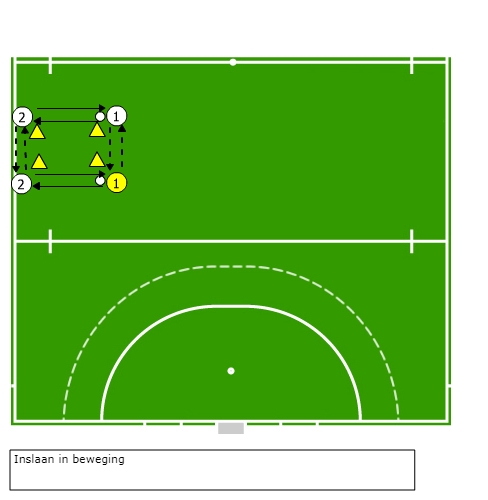
Variations:
- You can vary the way of passing (hitting, push, flats)
- Increase the distance between the pilons that players only has to run further.
- Increase the distance between the pilons that players have to pass over longer distances
- Increase both distances.
- Increase speed.
- Make as many successful passes as possible in time.
Points of attention:
- Sit low for a good control.
- Stick to the ground at ball control.
- Play the ball on the forehand side.
- Stand still while performing a ball control.
- Person 1 dribbles with the ball, does a 3D trick
- and passes a backhand to player 2 while running.
- Player 2 passes the ball to player 3 in the run.
- He dribbles along the obstacles and does a 3D trick at the end,
- Then player 3 hits the goal with a backhand shot.
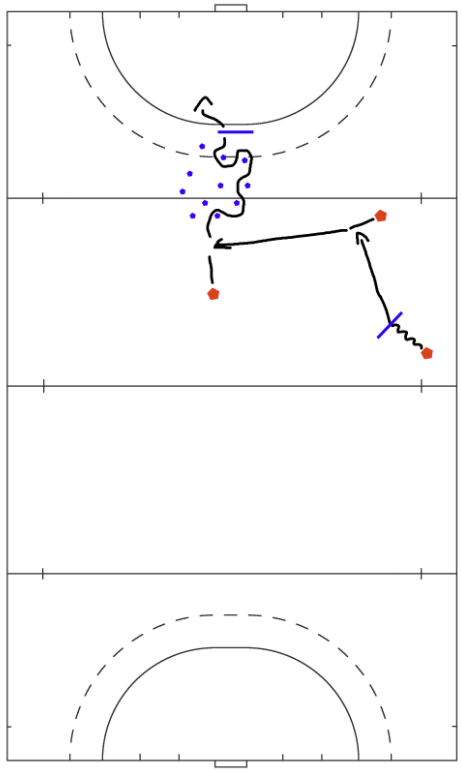
- Balls are at the first pilon.
- The player at the first pilon passes the ball to the second pilon,
- who pushes the ball through the pilons to the third person.
- The third person runs in on the ball and runs even further,
- then he pushes the ball to person 4 while he's running.
- Person 4 runs around the pilons and passes the ball at the top of the circle,
- where person 5 has just run up to finish the ball in the goal.
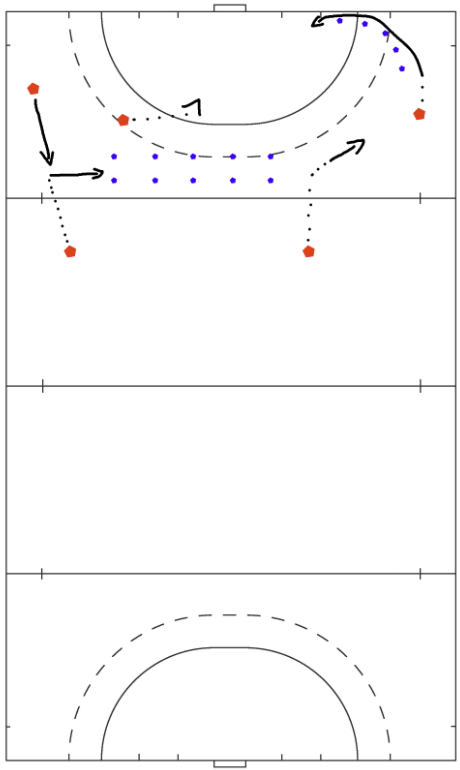
Aim:
Getting warm through a combination of passing, running and controlling the ball while running or standing still.
Set up:
This exercise also known in volleyball. The pilons are not quite in a triangle. It is possible, depending on the number of players, to set up multiples of the exercise.
1. The player at A plays the ball straight on to the player at B.
2. The player at B plays the ball to the player at C and runs towards point A.
3. The player at C receives the ball at point D and passes it to point A.
4. For the substitution A goes to B, B via D to C and C to A.

Variations:
- The stroke can be varied. (hitting, push, flats)
- The distances can be increased or decreased to adjust the level of difficulty.
- Pilons can be placed to play in between. This to increase the accuracy. When you make the pilons smaller, the difficulty increases.
- To play the ball from C to D, it can be bounced.
- To play the ball from D to A, it can be bounced.
- You can also place point C on the other side so that you turn backhand and forehand.
- When you place point C in 90 degrees from point B, you can rotate the same exercise only then from a different angle at point D.
- When you put down different situations, you can let the exercise rotate. Situation A is the standard, with situation B the exercise is mirrored, with situation C the exercise is set up in such a way that point B and C are at 90 degrees from each other and situation D is a mirror of situation C.
Points of attention:
- As a trainer you can take a good look at the different techniques of your players.
- Sit low when controlling the ball
- When playing the ball from C to D, the ball must not pass too far in the direction of A. The aim is for the player coming from B to take the ball at right angles.
- Play where possible on the forehand.
- Stand ready to control the ball. (low to the ground, stick on the ground)
- Put out gates of pilons (2 meters wide). from sideline to sideline.
- Players get 3 balls on the sideline
- any ball they can pass through a gate
- In advance, the player indicates which gate he is going to play through
- Each gate has points, the further the gate the higher the points:
- 10 Meter gate = 1 point
- 15 meter gate =5 points
- 20 meter gate = 10 points
- 30 meter gate is =20 points
- 40 meter gate = 30 points
- See how many points each player scores, this makes it clear to the players that a long-distance pass is often not very accurate.
- In addition, you can show that pushing and flatting can be much more convenient than hitting.
- You can put (depending on the level) a square of 3M x3M on the field and if the players score and the ball lands in the square it is worth 50 points.
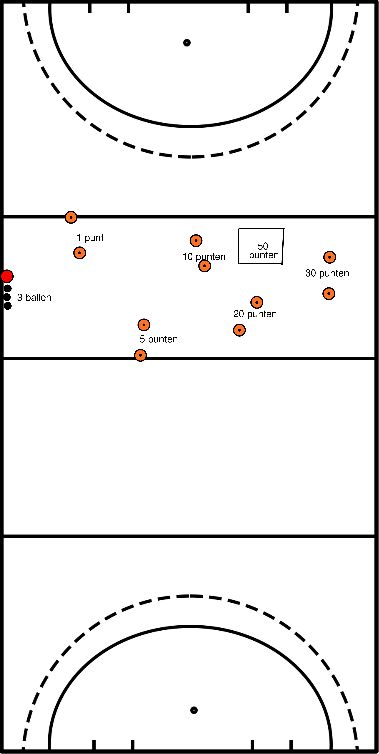
- Place all the hoops in the room (islands).
- On the outer side of the square, dribble with the ball to the left, dribble to a hoop and stand in it with the ball.
- Dribble around the corner to the right
- On the trainer's sign, dribble inside the square around 5 different hoops, counterclockwise.
- change the number of hoops
- always go to a different color hoop

- Dribble through the mines and make sure you don't hit them, then score on target.
- dribble through the mines faster and faster, avoid hitting them.
- Pilons are getting closer together
- throw loose mines in front of the children's feet that they have to dodge








